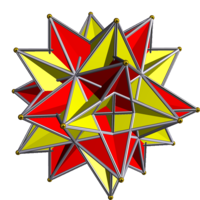Compound of two great icosahedra
(Redirected from Small retrosnub disoctahedron)
| Compound of two great icosahedra | |
|---|---|
 | |
| Rank | 3 |
| Type | Uniform |
| Notation | |
| Bowers style acronym | Sirsido |
| Elements | |
| Components | 2 great icosahedra |
| Faces | 24 triangles, 16 triangles as 8 hexagrams |
| Edges | 12+48 |
| Vertices | 24 |
| Vertex figure | Regular pentagram, edge length 1 |
| Measures (edge length 1) | |
| Circumradius | |
| Inradius | |
| Volume | |
| Dihedral angle | |
| Central density | 14 |
| Number of external pieces | 264 |
| Level of complexity | 36 |
| Related polytopes | |
| Army | Semi-uniform Toe, edge lengths (squares), (between ditrigons) |
| Regiment | Passipsido |
| Dual | Compound of two great stellated dodecahedra |
| Conjugate | Compound of two icosahedra |
| Convex core | Octatruncated tetrakis hexahedron |
| Abstract & topological properties | |
| Flag count | 240 |
| Orientable | Yes |
| Properties | |
| Symmetry | B3, order 48 |
| Flag orbits | 5 |
| Convex | No |
| Nature | Tame |
The small retrosnub disoctahedron, sirsido, or compound of two great icosahedra is a uniform polyhedron compound. It consists of 40 triangles (8 pairs of which form hexagrams due to following in the same plane), with five faces joining at a vertex.
It can be constructed from the pentagrammatic snub pseudodisoctahedron by replacing each small stellated dodecahedron with the great icosahedron with which it shares its edges.
Gallery[edit | edit source]
Vertex coordinates[edit | edit source]
Its vertices are the same as those of its regiment colonel, the pentagrammatic snub pseudodisoctahedron.
External links[edit | edit source]
- Bowers, Jonathan. "Polyhedron Category C4: Ikers" (#24).
- Klitzing, Richard. "sirsido".
- Wikipedia contributors. "Compound of two great icosahedra".






